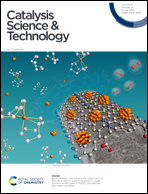Development of Ni-based alloy catalysts to improve the sulfur poisoning resistance of Ni/YSZ anodes in SOFCs
Abstract
Solid oxide fuel cells (SOFCs) are efficient energy conversion devices that convert chemical fuels such as hydrocarbons directly into electricity. In particular, at the anode of SOFCs an oxidation reaction of the fuel occurs. These fuels contain impurities including hydrogen sulfide, which can strongly contaminate the electrodes and thus degrade SOFC performance. Although developing a catalyst with high sulfur-poisoning resistance is inevitable, to this point the detailed mechanism of how sulfur poisoning occurs is still unclear. In this study, with the motivation of improving the conventional Ni/YSZ catalyst, we investigated the mechanism of sulfur poisoning on a variety of Ni-based alloy surfaces using density functional theory (DFT) calculations. The effects of alloying transition metals (Cu, Rh, Pd, Ag, Pt, and Au) into Ni stepped surfaces on the adsorption of intermediates and on the activation barriers during the H2S decomposition reaction were elucidated in order to suggest a way to alleviate this sulfur deposition. Our results will provide useful insights into the design of sulfur-tolerant SOFC anode materials in the future.



 Please wait while we load your content...
Please wait while we load your content...